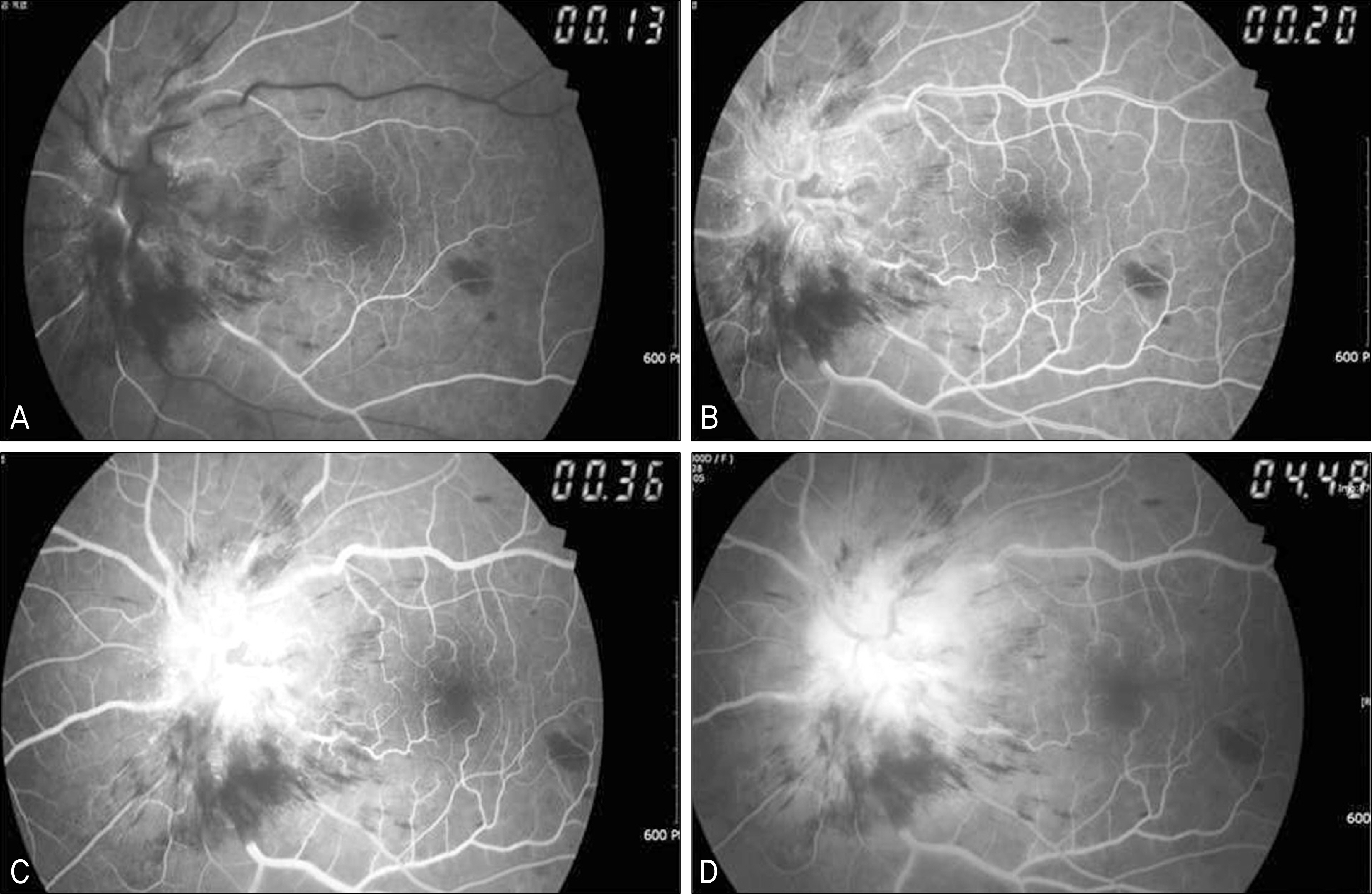J Korean Ophthalmol Soc.
2011 Feb;52(2):250-254.
Leukemic Infiltration of the Optic Nerve Head as the Initial Manifestation of Leukemic Relapse
- Affiliations
-
- 1Department of Ophthalmology, Soonchunhyang University College of Medicine, Bucheon, Korea. genophilus@hanmail.net
- 2Department of Internal Medicine, Soonchunhyang University College of Medicine, Bucheon, Korea.
Abstract
- PURPOSE
To present a case of leukemic infiltration of the optic nerve head as the initial manifestation of leukemic relapse.
CASE SUMMARY
A 65-year-old woman was diagnosed with acute myeloid leukemia. Complete remission was achieved after 4 complete courses of chemotherapy. She complained of a sudden decrease in visual acuity in her left eye. Fundus examination showed severe optic disc edema with peripapillary hemorrhage and serous retinal detachment. Visual acuity and fundus continued to aggravate and high-dose intravenous steroid therapy was instituted. Visual acuity and fundus deteriorated more after treatment. Brain magnetic resonance imaging and CSF study were normal but intrathecal chemotherapy and focal irradiation were performed on account of the suspected CNS involvement of leukemia. Morphologic improvement in the retinal structure was achieved, however, optic atrophy remained and her vision did not recover.
CONCLUSIONS
The present case shows the involvement of the optic nerve head as the initial isolated manifestation for the relapse in a patient with complete remission. CNS involvement is rare in acute myeloid leukemia and in particular, the optic nerve is rarely reported as the initial isolated presentation for the relapse. Moreover, the disease progression relatively aggravated after treatment. In the atypical aspects of leukemic relapse, the present case was noticeable.
MeSH Terms
Figure
Reference
-
References
1. Schachat AP, Markowitz JA, Guyer DR, et al. Ophthalmic manifestations of leukemia. Arch Ophthalmol. 1989; 107:697–700.
Article2. Kim JW, Baek CM, Kim KS. A case of chronic myelogenous leukemia involving retina and optic nerve. J Korean Ophthalmol Soc. 2003; 44:2687–93.3. Sharma T, Grewal J, Gupta S, Murray PI. Ophthalmic manifestations of acute leukaemias: the ophthalmologist's role. Eye. 2004; 18:663–72.
Article4. Lin YC, Wang AG, Yen MY, Hsu WM. Leukaemic infiltration of the optic nerve as the initial manifestation of leukaemic relapse. Eye. 2004; 18:546–50.
Article5. Mayo GL, Carter JE, McKinnon SJ. Bilateral optic disk edema and blindness as initial presentation of acute lymphocytic leukemia. Am J Ophthalmol. 2002; 134:141–2.
Article6. Castagnola C, Nozza A, Corso A, Bernasconi C. The value of combination therapy in adult acute myeloid leukemia with central nervous system involvement. Haematologica. 1997; 82:577–80.7. Rosenthal AR. Ocular manifestations of leukemia. A review. Ophthalmology. 1983; 90:899–905.8. Russo V, Scott IU, Querques G, et al. Orbital and ocular manifestations of acute childhood leukemia: clinical and statistical analysis of 180 patients. Eur J Ophthalmol. 2008; 18:619–23.
Article9. Costagliola C, Rinaldi M, Cotticelli L, et al. Isolated optic nerve involvement in chronic myeloid leukemia. Leuk Res. 1992; 16:411–3.
Article10. Nikaido H, Mishima H, Ono H, et al. Leukemic involvement of the optic nerve. Am J Ophthalmol. 1988; 105:294–8.
Article11. Wallace RT, Shields JA, Shields CL, et al. Leukemic infiltration of the optic nerve. Arch Ophthalmol. 1991; 109:1027.
Article
- Full Text Links
- Actions
-
Cited
- CITED
-
- Close
- Share
- Similar articles
-
- Leukemic Infiltration of the Optic Nerve Head: A Case Report
- Enhancement of Optic Nerve in Leukemic Patients: Leukemic Infiltration of Optic Nerve versus Optic Neuritis
- A Case of Optic Nerve Infiltration of Acute Lymphocytic Leukemia
- Testicular Leukemia
- A Case of Leukemic Infiltration of Parotid Gland Preceding the Clinical Onset of Acute Lymphoblastic Leukemia




